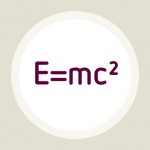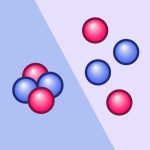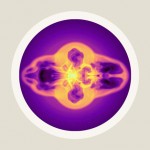From E=mc² to the atomic bomb
The subtle connections between Einstein’s formula, nuclear fission and nuclear fusion
An article by Markus Pössel
When Einstein’s most famous formula E=mc² is mentioned, the atomic bomb is usually not far behind. Indeed there is a connection between the two, but it is subtle, and sadly, some popular science texts get it wrong: they will tell you that a nuclear explosion is “caused by the transformation of matter and energy” according to Einstein’s formula, and that the gigantic conversion factor c2 is responsible for the immense power of such weapons.
![[Image: Los Alamos National Laboratory]](https://www.einstein-online.info/wp-content/uploads/trinity_jpg-1.jpg)
Ten seconds after the ignition of the first atomic bomb, New Mexico, July 16, 1945 [Image: Los Alamos National Laboratory]
But first things first. Let’s have a look at what Einstein really did say about the relation between mass and energy.
Equivalence or transformation?
For Einstein, mass (more precisely: relativistic mass; the property that determines how difficult it is to change a body’s speed or its direction of motion) and energy are simply two different names for one and the same physical quantity. Whenever a system has an energy E, it automatically has the relativistic mass m=E/c2; whenever a system has the mass m, you need to assign it an energy E=mc2. Once the mass is known, so is the energy, and vice versa. In that context, it makes no sense to talk about the “transformation of mass into energy” – where there’s one, there’s the other.
The context in which “transformation of mass into energy” does make sense is a bit different. It is intimately connected with the fact that there are different kinds of energy. Already in classical, pre-Einstein physics, the concept of “energy” comprises a plethora of sub-definitions for different sorts of energy, sub-definitions like those for the kinetic energy associated with any moving body, the energy of electromagnetic radiation, thermal energy or the binding energy that needs to be taken into account whenever there is a force holding together two objects to form a composite object. Yet all these different definitions can be viewed as facets of a single physical quantity, energy. The reason is the possibility of transformations between the different energy forms. For instance, you can increase a body’s temperature (and thus its thermal energy) by letting it absorb electromagnetic radiation energy. In these transformations, the total sum of all the different kinds of energy – the total energy – is constant over time. Energy can be transformed from one variety into another, but it can neither vanish nor be created from nothing.
A new kind of energy
This conservation of energy holds not only in classical physics, but also in special relativity. However, in relativity, the definitions of the different species of energy are a bit different and, most importantly, there is a completely new type of energy: even if a particle is neither moving nor part of a bound system, it has an associated energy, simply because of its mass. This is called the particle’s rest energy, and it is related to the particle’s rest mass as
rest energy = (rest mass)· c2.
Compared with other types of energy, rest energy is very much concentrated. For example: If you use a television tube to accelerate an electron to 20,000 kilometres per second, the kinetic energy gained is still only about five hundred times smaller than the electron’s rest energy. Also, this rest energy is about a hundred times larger than the radiation energy of a high-energy X-ray photon. This high concentration is important for processes where rest energy (or, equivalently, rest mass) is converted to more common forms of energy. For instance, when a particle and its anti-particle annihilate and vanish in a puff of electromagnetic radiation, comparatively little matter is transformed into rather a lot radiation.
Studying the masses of different types of atomic nuclei, you will find that in nuclear fission – the process that powers an ordinary atomic bomb -, some “nuclear rest energy” or “nuclear rest mass” is transformed into other forms of energy. For example, the rest mass of a nucleus of uranium-235 is slightly larger than the combined rest masses of the nuclear fragments into which it splits during nuclear fission. Here’s where E=mc2 comes into play: This mass difference corresponds to the energy set free during nuclear fission. So is it, after all, true that Einstein’s formula explains the power of the nuclear bomb – and that the large conversion factor c2 is responsible for the immense amounts of energy released?
Binding energies: nuclei vs. molecules
Not at all. Different process, same calculation: For chemical reactions, there are tiny mass differences as well. To pick an example: When hydrogen and oxygen explosively combine to make water, the sum of the rest masses of the initial hydrogen and oxygen atoms is just a little bit less than the sum of the rest masses of the resulting water molecules. The same is true for the chemical reactions involving spontaneous oxydation – in other words: burning. The same formula applies: The mass difference, multiplied by c2, gives the energy set free during the chemical reaction. Same formula, same conversion factor – yet chemical reactions are much less violent than nuclear explosions. This clearly shows that the difference between nuclear and chemical reactions must be due to something other than E=mc2.
To see where the difference lies, one must take a closer look. Atomic nuclei aren’t elementary and indivisible. They have component parts, namely protons and neutrons. In order to understand nuclear fission (or fusion), it is necessary to examine the bonds between these components. First of all, there are the nuclear forces binding protons and neutrons together. Then, there are further forces, for instance the electric force with which all the protons repel each other due to the fact they all carry the same electric charge. Associated with all of these forces are what is called binding energies – the energies you need to supply to pry apart an assemblage of protons and neutrons, or to overcome the electric repulsion between two protons. (More information about these binding energies and their role in nuclear fission and fusion can be found in the spotlight topic Is the whole the sum of its parts?)
Only with the systematics of these forces and binding energies well understood were physicists able to uncover the laws behind nuclear fission and fusion: The strength of the nuclear bond depends on the number of neutrons and protons involved. It varies in such a way that binding energy is released both in splitting up a heavy nucleus into smaller parts and in fusing light nuclei into heavier ones. This, as well as the chain reaction phenomenon, explains the immense power of nuclear bombs.
Einstein’s formula plays second fiddle in that derivation – it’s all about different kinds of energy. Sure, there are some radioactive decay processes following nuclear fission, and, if so inclined, one can view the decay of a neutron decaying into a slightly lighter proton as a transformation of rest energy into other energy forms. But these additional processes contribute a mere 10 per cent of the total energy set free in nuclear fission. The main contribution is due to binding energy being converted to other forms of energy – a consequence not of Einstein’s formula, but of the fact that nuclear forces are comparatively strong, and that certain lighter nuclei are much more strongly bound than certain more massive nuclei.
Still, E=mc2 had a supporting role in the story of nuclear fission research. Not as the mechanism behind nuclear power, but as a tool: Because energy and mass are equivalent, highly sensitive measurements of the masses of different atomic nuclei gave the researchers important clues about the strength of the nuclear bond. Einstein’s formula does not tell us why the nuclear binding energies are as large as they are, but it opens up one way (among several) to measure these binding energies. (More about this application of Einstein’s formula can be found in the spotlight topic Is the whole the sum of its parts?)
In fact, Einstein’s politics played a more decisive role in the story of the atomic bomb than his physics. Following a request by the physicist Leo Szilard, Einstein wrote a letter to president Roosevelt, explaining about the potential power of nuclear weapons and the possibility of Nazi Germany developing such weapons, and urging the president to take action. Einstein’s letter played its part in setting into motion the political process that culminated in the Manhattan project – the development, construction and testing of the first nuclear bombs.
Further Information
E=mc2 is a consequence of special relativity. More on that theory can be found in the chapter Special relativity of Elementary Einstein.
Related Spotlights on Relativity can be found in the section Special relativity.
Information about the historical background can be found on the page
on “Einstein – Image and Impact”, a website of the American Institute of Physics.
Colophon
is the managing scientist at Haus der Astronomie, the Center for Astronomy Education and Outreach in Heidelberg, and senior outreach scientist at the Max Planck Institute for Astronomy. He initiated Einstein Online.
Citation
Cite this article as:
Markus Pössel, “From E=mc² to the atomic bomb” in: Einstein Online Band 04 (2010), 01-1004










